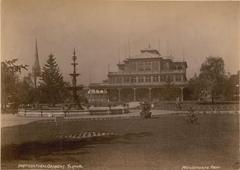
Allan Gardens Toronto: Visiting Hours, Tickets, and a Comprehensive Historical Guide
Date: 15/06/2025
Introduction: Toronto’s Urban Botanical Treasure
Allan Gardens, located in the heart of downtown Toronto, stands as a living testament to the city’s horticultural heritage, urban evolution, and cultural vibrancy. Established in 1858 through the philanthropy of George William Allan, the city’s 11th mayor, this beloved public park and conservatory complex has welcomed generations of locals and visitors alike. Today, Allan Gardens offers a year-round botanical retreat, free admission, and a rich tapestry of history, making it one of Toronto’s most accessible and captivating attractions (Destination Ontario; BlogTO).
This detailed guide explores Allan Gardens’ storied past, architectural evolution, and enduring cultural significance, while providing up-to-date practical information on visiting hours, tickets, accessibility, and nearby attractions. Whether you are a history buff, plant enthusiast, or simply seeking a peaceful urban escape, Allan Gardens delivers an immersive and memorable experience.
Table of Contents
- Introduction
- The Founding and Early Development (1819–1860)
- Landscape Design and Victorian Vision
- Growth of the Conservatories
- Social and Civic Importance
- Heritage Status and Preservation
- Modern Community Engagement
- Visiting Allan Gardens: Essential Information
- Botanical Collections and Seasonal Highlights
- Cultural and Educational Programming
- Nearby Attractions and Neighborhood Guide
- Frequently Asked Questions (FAQ)
- Plan Your Visit: Tips and Summary
- References
The Founding and Early Development (1819–1860)
The origins of Allan Gardens date back to 1819, when William Allan, a notable merchant and banker, acquired land on Toronto’s expanding outskirts. Upon his death, his son George William Allan inherited the estate and became a driving force behind the city’s horticultural advancement. In 1858, George Allan donated five acres to the Toronto Horticultural Society, Canada’s first such organization, established in 1834 (City of Toronto Heritage Report; Toronto Travel Guide).
On March 14, 1860, the gardens were formally opened. A highlight of the inauguration was the Prince of Wales (later King Edward VII) planting a maple tree, symbolizing Allan Gardens’ national significance (Destination Ontario).
Landscape Design and Victorian Vision
The initial vision for Allan Gardens reflected 19th-century ideals of picturesque landscape architecture. Edwin Taylor, a prominent landscape designer, was commissioned to develop a plan featuring winding paths, flowerbeds, and a central terrace. By 1864, the City of Toronto assumed ownership, ensuring the gardens’ preservation as a public space (City of Toronto Heritage Report). Bordered by Gerrard, Sherbourne, Carlton, and Jarvis Streets, Allan Gardens quickly became a cornerstone of civic life.
Growth of the Conservatories
Allan Gardens is especially renowned for its historic greenhouses. The original 1860 pavilion, a hub for horticultural shows and public gatherings, was replaced after a fire in 1879. In 1910, the iconic Palm House—a glass-domed, cast-iron structure—was completed, and remains one of North America’s oldest conservatories (BlogTO). Over the 20th century, additional greenhouses were added: the Tropical House, Temperate House, Arid House, Begonia and Orchid Houses, and, in 2003, the Botany Greenhouse relocated from the University of Toronto (Friends of Allan Gardens).
Social and Civic Importance
From its earliest days, Allan Gardens has played a vital role beyond horticulture. In 1896, it served as the birthplace of the National Council of Women of Canada and hosted a landmark suffragette “mock parliament” (Storeys). Over the decades, the park has become a venue for rallies, protests, and gatherings, reflecting the city’s evolving social and political landscape. Today, it continues to serve as a meeting place for community, activism, and support for marginalized groups.
Heritage Status and Preservation
Allan Gardens’ significance is officially recognized through its inclusion on Toronto’s Inventory of Heritage Properties (1973) and its designation under the Ontario Heritage Act (1986). Both the landscape and its historic structures—including the Palm House—are protected. The site also holds archaeological value, with evidence of Indigenous presence and early European settlement (City of Toronto Heritage Report).
Modern Community Engagement
The surrounding Garden District has transformed with Toronto’s growth. Victorian villas gave way to apartments and community services, while the park itself adapted with playgrounds, dog areas, and expanded conservatories (Friends of Allan Gardens). The Friends of Allan Gardens, a volunteer organization founded in 1990, partners with the city to restore historic features, animate the park, and deliver inclusive programming—including Indigenous cultural events and educational outreach (Toronto For You).
Visiting Allan Gardens: Essential Information
Hours and Admission
- Conservatory Hours: Daily, 10:00 AM – 5:00 PM (hours may vary on holidays and for special events; confirm via the official City of Toronto website or Friends of Allan Gardens calendar).
- Admission: Free. Donations are welcome to support garden maintenance and programming.
Accessibility
- Fully wheelchair accessible (ramps, paved paths, accessible washrooms).
- Service animals permitted inside the conservatory.
Getting There
- Address: 19 Horticultural Ave, Toronto, ON M5A 2P2 (main entrance at Gerrard St. East & Jarvis St.)
- Transit: TTC streetcars and buses stop nearby; Queen, College, and Dundas subway stations are within walking distance.
- Parking: Limited paid street parking and nearby Green P lots (e.g., 405 Sherbourne St). Public transit is recommended.
Visitor Tips
- Best Times: Spring and summer for outdoor blooms; winter for tropical escapes.
- Quietest Hours: Weekday mornings.
- Amenities: Benches, accessible restrooms, picnic areas; no on-site gift shop.
Botanical Collections and Seasonal Highlights
Allan Gardens spans over 16,000 square feet of interconnected greenhouses, each representing distinct ecosystems (We Love Toronto; Icy Canada):
- Palm House: Towering tropical palms, rare cycads, and lush banana plants in a soaring glass dome (Toronto.ca).
- Tropical Landscape House: Jade vine, citrus trees, orchids, aquatic plants, and a serene pond.
- Cool Temperate House: Camellias, azaleas, and temperate flora with ornamental fish and turtles.
- Arid House: Cacti and succulents from global deserts.
- Begonia and Orchid Houses: Exotic begonias, orchids, and bromeliads.
- Seasonal Displays: Poinsettias and festive décor in winter; crocuses, hyacinths, and primulas in spring.
Rare and heritage plant specimens are featured year-round, supporting biodiversity and conservation (Toronto.ca).
Cultural and Educational Programming
Community Events
- Flower Shows: Seasonal indoor displays and annual Christmas Flower Show.
- Farmers’ Markets: Saturdays, 10 AM–2 PM, featuring local produce and plant sales (Friends of Allan Gardens).
- Workshops: Gardening, seedling care, and sustainable urban agriculture.
- Cultural Festivals: Nowruz (Persian New Year), multicultural celebrations, and musical performances.
- Walking Tours: Jane’s Walks and historical tours led by local experts.
Educational Initiatives
- Children’s Conservatory and Teaching Garden: Hands-on horticultural activities, environmental education for families, and school groups (Friends of Allan Gardens).
- Conservation Focus: Propagation of rare/native plants and sustainability partnerships with local organizations (We Love Toronto).
Nearby Attractions and Neighborhood Guide
Allan Gardens’ central location makes it a great starting point for exploring Toronto’s top sites:
Museums & Galleries
- Royal Ontario Museum (ROM): Artifacts and natural history (Royal Ontario Museum)
- Art Gallery of Ontario (AGO): Extensive Canadian and world art collections (Art Gallery of Ontario)
Historic & Cultural Districts
- Distillery District: Victorian industrial architecture, shops, and festivals (Distillery District)
- Kensington Market: Eclectic shops, cafes, and international cuisine (Kensington Market)
- St. Lawrence Market: Historic food market with fresh and artisanal goods (St. Lawrence Market)
Parks & Outdoor Spaces
- Toronto Islands: Beaches, trails, and family activities (Toronto Islands)
- High Park: Trails, gardens, and a zoo (High Park)
Landmarks & Family Fun
- CN Tower: City views and EdgeWalk experience (CN Tower)
- Ripley’s Aquarium of Canada: Marine exhibits and interactive displays (Ripley’s Aquarium)
- Ontario Science Centre: Interactive science and technology (Ontario Science Centre)
Dining & Shopping
- Church-Wellesley Village: LGBTQ+ nightlife, cafes, and Pride events (Church-Wellesley Village)
- Eaton Centre: Premier downtown shopping (Toronto Eaton Centre)
Frequently Asked Questions (FAQ)
Q: What are Allan Gardens’ visiting hours?
A: The conservatory is open daily from 10:00 AM to 5:00 PM. Outdoor park areas are accessible from dawn to dusk. Always check the official website for updates.
Q: Is there an admission fee or need for tickets?
A: No, admission is free for both the conservatory and park.
Q: Is Allan Gardens wheelchair accessible?
A: Yes, the conservatory and park have accessible paths and restrooms.
Q: Are pets allowed?
A: Pets are not permitted inside the conservatory, but are allowed in the outdoor park (on leash).
Q: Are guided tours available?
A: Guided tours and workshops are sometimes offered—check the Friends of Allan Gardens calendar for current offerings.
Q: Is photography allowed?
A: Yes, respectful personal photography is welcome; tripods are allowed unless obstructing pathways.
Plan Your Visit: Tips and Summary
Allan Gardens is a year-round destination for plant lovers, families, and anyone seeking an oasis in Toronto’s urban core. With free, accessible entry and a constantly changing array of botanical and cultural experiences, it’s an essential stop for visitors and locals. For a seamless visit:
- Arrive on weekday mornings for a tranquil experience.
- Check the official Allan Gardens page and Friends of Allan Gardens calendar for event listings and updates.
- Explore nearby museums, historic districts, and parks to round out your Toronto itinerary.
For personalized travel guides, up-to-date events, and more Toronto insights, download the Audiala app and follow our social channels.
References and Further Reading
- Allan Gardens, 2021, Destination Ontario (Destination Ontario)
- History of Allan Gardens Conservatory, 2021, BlogTO (BlogTO)
- Allan Gardens Heritage Report, 2012, City of Toronto (City of Toronto Heritage Report)
- Guide to Allan Gardens Toronto, 2024, Toronto Travel Guide (Toronto Travel Guide)
- Allan Gardens History, 2024, Friends of Allan Gardens (Friends of Allan Gardens)
- Allan Gardens Visiting Tips, 2024, Toronto2Anywhere (Toronto2Anywhere)
- A Trip Guide to Allan Gardens, 2024, Icy Canada (Icy Canada)
- Allan Gardens Reflects Toronto’s History, 2024, Storeys (Storeys)
- Allan Gardens Calendar and Events, 2024, Friends of Allan Gardens (Friends of Allan Gardens)
- Allan Gardens Conservatory Official Page, 2024, City of Toronto (Toronto.ca)



























































































































































































